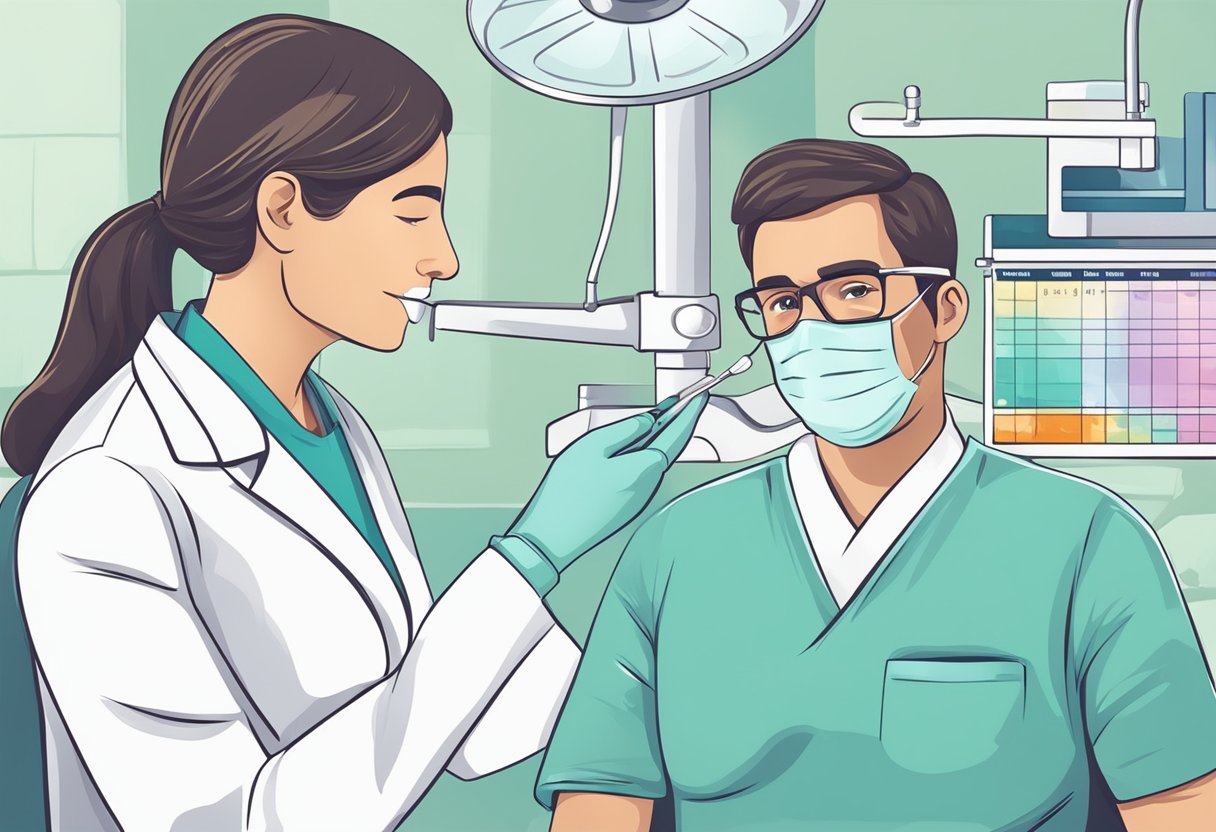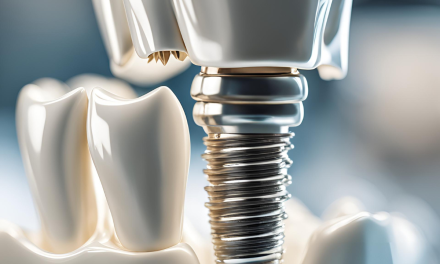Gum infections, also known as periodontal diseases, are inflammatory conditions affecting the tissues surrounding and supporting the teeth. They can be triggered by a variety of factors, including poor oral hygiene, genetics, smoking, and certain medical conditions. Recognizing the symptoms of gum infection is crucial for early intervention and treatment, which may include professional dental care and home remedies.

The treatment of gum infections often requires a multifaceted approach. Professional dental procedures such as deep cleaning can remove the buildup of plaque and tartar that contribute to infection. Meanwhile, at-home care strategies, such as saltwater rinses, can help manage symptoms and aid recovery. Maintaining proper oral hygiene and periodic dental check-ups are vital for preventing the recurrence of gum infections.
Key Takeaways
- Gum infections require early detection and a combination of treatments.
- Professional dental care is a cornerstone of effective gum disease management.
- Good oral hygiene practices are essential for both treatment and prevention.
Understanding Gum Infections
Gum infections, clinically recognized as periodontal diseases, are primarily caused by bacteria in plaque leading to oral health complications if left untreated. They manifest in various stages from initial inflammation to severe damage of gum and bone tissue.
Causes of Gum Infections
Gum infections begin when plaque, a sticky film of food debris, bacteria, and saliva, accumulates on teeth. If not regularly removed through brushing and flossing, plaque can harden into tartar. This harbors bacteria, ultimately leading to gum disease.
Symptoms of Gum Infections
Gingivitis, the earliest stage of gum disease, may present with red, swollen gums that bleed easily. As the infection progresses to periodontitis, symptoms can escalate to persistent bad breath, gum recession, and even loose teeth as the supporting tissue and bone are affected.
Stages of Gum Disease
- Gingivitis: Characterized by gum inflammation without loss of bone.
- Mild to Moderate Periodontitis: Marked by deeper inflammation, gums may start to pull away from the teeth, forming pockets susceptible to further infection.
- Advanced Periodontitis: In this final stage, the fibers and bone supporting the teeth are destroyed, which could lead to tooth loss if preventive measures aren’t taken.
Roles and Risks
Effective management of gum infections hinges on understanding their prevention through oral hygiene and being aware of the factors that elevate the risk of development.
Role of Oral Hygiene in Prevention
Maintaining excellent oral hygiene is the cornerstone of preventing gum infections. Regular brushing and flossing minimize the accumulation of plaque, which can harbor bacteria leading to gum disease. The use of antibacterial mouthwash can further aid in keeping oral bacteria in check. Dental professionals emphasize the importance of biannual cleanings as they can remove tartar, which brushing alone cannot.
Risk Factors for Gum Infections
Several factors contribute to the increased risk of developing gum infections. Genetics might predispose some individuals more than others, making it imperative for them to pay closer attention to their oral health. Conditions like diabetes are known to heighten the risk due to their impact on the body’s immune response. Furthermore, habits such as smoking and other tobacco use are major contributors to gum disease, as they impair the mouth’s natural healing processes. Hormonal changes in women can also make them more susceptible to gum infections. Poor oral hygiene, above all, is a principal risk factor that is directly controllable through adequate dental care practices.
Professional Diagnosis
In the face of a gum infection, seeking a professional diagnosis is critical. A dentist identifies the extent of the gum disease using precise diagnostic procedures, laying the groundwork for effective treatment.
Dental Examination Process
During the dental examination process, a dentist conducts a visual inspection and uses special tools to measure the depth of the pockets between the teeth and gums, which is indicative of gum health. X-rays may also be taken to detect any bone loss and to assess the severity of the infection. The dentist may also test for tooth mobility and check for areas of bleeding or pus, which can signal infection.
It is essential to perform a full periodontal assessment because the manifestations of gum disease are not always visible to the naked eye. This comprehensive approach ensures that all aspects of the disease are identified and can be addressed.
Importance of Early Detection
Early detection of gum disease is paramount for successful intervention. Detecting the condition early means dental procedures can be less invasive and more cost-effective, with a higher likelihood of preserving the natural teeth and gum structure. Moreover, early treatment of gum disease can prevent its progression to more significant health issues, as there is a known association between periodontal disease and systemic conditions like heart disease and diabetes.
By recognizing the signs of gum infection promptly, a tailored treatment plan can be established to mitigate the infection and restore oral health. The role of the dentist in diagnosis and early intervention cannot be overstated; they are key to combating periodontal disease effectively.
Treatment Options
Effective gum infection treatment can significantly reduce inflammation and improve oral health. Both nonsurgical and surgical treatments are available, depending on the severity of the infection.
Nonsurgical Treatments
For early stages of gum infections, nonsurgical therapies are often the first course of action. These include:
- Scaling and Root Planing: This is a deep-cleaning procedure where plaque and tartar are removed from above and below the gumline. Root planing involves smoothing out the roots of the teeth, helping the gums reattach to the teeth.
- Antibiotics: Antibacterial medications can be prescribed to help control infection. They may be administered orally or as a topical gel applied directly into the gum pockets.
Surgical Treatments
In cases where nonsurgical treatments cannot fully address the issue, surgical treatments may be necessary, which include:
- Flap Surgery (Pocket Reduction Surgery): During this procedure, the gums are lifted back so that tartar can be removed. The gums are then sutured back in place to fit closely around the tooth, reducing the space for bacteria to grow.
- Guided Tissue Regeneration: This technique involves placing a regenerative material between the bone and tooth, which encourages the natural regrowth of bone and gum tissue lost due to periodontitis.
Dental Cleaning and Maintenance
Effective treatment of gum infections necessitates a two-pronged approach: thorough dental cleanings by professionals and diligent home care routines. Both methods are essential to address periodontitis and prevent its progression.
Professional Dental Cleanings
Professional dental cleanings go beyond routine brushing and are imperative for maintaining oral health. These cleanings should typically be performed every six months, although more frequent visits may be necessary for individuals with signs of gum disease. Scaling is a common procedure used to remove plaque and tartar from teeth, particularly below the gumline, which is crucial for curing gum infections. More advanced stages of periodontitis may require deep cleaning, which involves a process known as root planing. This is where the roots of the teeth are smoothed to promote adhesion of the gums to the tooth, reducing the risk of future infections.
Home Care and Daily Routines
In conjunction with professional dental cleanings, a robust home care routine is a strong defense against gum infections. An effective routine includes:
- Brushing teeth at least twice a day with a fluoride toothpaste. Optimally, use a toothbrush with soft bristles to avoid gum and enamel damage.
- Flossing daily using dental floss to remove food particles and plaque that a toothbrush cannot reach.
- Employing a water flosser can be particularly beneficial for those with braces or dental appliances, as it can clean around these structures effectively.
- It’s recommended that individuals use toothpaste containing fluoride, as fluoride helps to strengthen the teeth and prevent cavities.
It is important to remember to replace one’s toothbrush every three to four months or sooner if the bristles are frayed, to ensure effective cleaning. By adhering to these daily dental cleaning practices, one can significantly impact the prevention and management of gum infections.
Home Remedies and Care
When dealing with gum infections, certain home remedies can complement good oral hygiene practices to alleviate symptoms and promote healing. Warm salt water, for example, is a well-regarded tool for oral care that can soothe inflamed gums.
Natural Remedies for Gum Health
One of the primary home remedies for maintaining gum health is the use of warm salt water rinses. Dissolving a teaspoon of salt in a cup of warm water creates a simple yet effective solution. Here’s how:
- Salt Water Rinse: Rinse the mouth with the solution for about 30 seconds, then spit it out. Repeat two to three times daily.
Natural substances also play a role in oral health:
- Tea Tree Oil: A few drops in a glass of water can act as a natural mouthwash.
- Aloe Vera: Applying directly to the gums to reduce inflammation and soothe pain.
Please note, these remedies should not replace professional medical advice or treatment.
Lifestyle Changes for Better Oral Health
Adopting healthy lifestyle habits is critical for gum disease prevention and overall oral health. This includes:
- Regular Brushing and Flossing: Brush at least twice a daily with fluoride toothpaste and floss to remove plaque.
- Dietary Adjustments: Reduce intake of sugary foods and drinks, which can contribute to plaque buildup and gum disease.
- Smoking Cessation: Smoking can exacerbate gum infections and hinders healing.
Maintaining regular visits to the dentist for cleanings and check-ups is an integral part of any oral health routine.
Understanding the Complications
When a gum infection is left untreated, it can lead to severe oral health complications that may extend to systemic issues. Individuals must recognize the consequences of gum infections and the broader implications on overall health.
Consequences of Untreated Infections
Gum infections, when not promptly and effectively managed, can escalate to significant dental problems. Persistent infections can result in tooth loss due to the destruction of the supporting structures around teeth. In some cases, neglected diseases lead to bone loss in the jaw, a severe condition that can complicate possibilities for dental restorations. Receding gums are another common complication which could expose the roots of the teeth, making them more susceptible to decay and sensitivity.
Additionally, dental abscesses can form, which are pockets of pus resulting from the infection. These abscesses not only cause severe pain but can also spread the disease beyond the oral cavity if not appropriately treated.
Systemic Health and Gum Infections
The implications of gum infections can surpass dental health and affect one’s overall well-being. Research suggests a possible link between chronic gum infections and systemic health issues such as heart disease and certain types of cancer, though these relationships are complex and multifaceted. The inflammation and bacteria associated with periodontal disease may have a role in exacerbating these systemic conditions, emphasizing the importance of maintaining oral health as part of managing general health.
Innovations in Gum Care
Recent advancements in gum care have paved the way for improved treatments and a better understanding of periodontal diseases. These innovations not only aim to heal infections but also enhance overall oral health maintenance.
Advancements in Periodontal Treatments
Modern periodontal treatment has significantly progressed due to technological breakthroughs and refined medical practices. The National Institute of Dental and Craniofacial Research supports ongoing efforts to develop more effective methods to diagnose and treat gum disease. For instance, laser therapy has emerged as a minimally invasive option that targets infected areas with precision, reducing pain and recovery time.
Tissue engineering is another field that redefines periodontal therapy. Growth factors and scaffolds are being studied for their potential to regenerate bone and gum tissue lost to periodontitis, a severe infection that can cause tooth loss. This regenerative approach promises a leap forward from traditional surgery, potentially allowing patients to regrow lost tissues.
Research and Studies
Research into gum care continuously brings new insights into dental health. The Merck Manual Professional Version offers detailed guidance on the clinical presentation and management of gum infections, backing treatment plans with the latest studies. The Mayo Clinic contributes by educating patients on the importance of early detection and the implication of gum health on systemic wellbeing.
A key focus area of current studies is the host response to bacterial plaque, with investigations seeking to understand why some individuals are more susceptible to severe gum infections than others. The Centers for Disease Control and Prevention (CDC) tracks the prevalence of gum disease across populations, providing critical data that informs public health policies and preventative care strategies.
As research progresses, these entities continue to provide robust, evidence-based resources that inform both dental professionals and the public, fostering advancements in the battle against gum disease.
Preventing Gum Infections
To maintain the health of one’s gums, it is crucial to commit to a regimen that encompasses both systematic prevention strategies and meticulous oral hygiene best practices.
Effective Prevention Strategies
They can take several proactive steps to keep gum infections at bay. Avoiding sugary foods and beverages can significantly reduce the risk of gum disease. It’s beneficial to eat a balanced diet that supports overall dental health. Regular dental check-ups are essential for early detection and prevention of potential issues. Stopping tobacco use in any form can also lower the risk of developing gum infections.
Oral Hygiene Best Practices
Good oral hygiene is the cornerstone of preventing gum infections. They should brush their teeth at least twice daily, using a fluoride toothpaste which helps to remove plaque—a transparent, sticky film of bacteria that can harden into tartar if not removed. It’s also important for them to floss daily to clean the spaces between the teeth where a toothbrush can’t reach. Using an antimicrobial mouthwash can offer additional protection by reducing bacteria in the mouth. They should replace their toothbrush every three to four months, or sooner if the bristles are frayed.
When to See a Dentist
It is crucial to recognize when gum issues warrant professional dental care. Timely visits to the dentist can prevent the progression of gum infections and further complications.
Identifying the Need for Professional Help
One should seek a dentist’s assistance when exhibiting symptoms of gum infection. These symptoms could include persistent pain, bleeding when brushing or flossing, and swelling in the gum area. The presence of pus or an unpleasant taste in the mouth also signals the need for dental evaluation. Early diagnosis and intervention can mitigate the risks of periodontitis, which, if left untreated, can lead to tooth loss or more severe health issues. For more information, consider reading about causes and treatment at Gum infection: Causes, treatment, home remedies, and more.
Regular Dental Check-Ups
Regular dental check-ups are imperative, even when symptoms are not present. A dentist can detect early signs of gum disease before it becomes apparent to the patient. Professional cleanings can remove plaque and tartar that brushing alone cannot, thus preventing the onset of gum infections. Check-ups typically include an assessment for signs of periodontitis, a serious gum condition detailed in the Mayo Clinic’s periodontitis article. Dental professionals recommend visits every six months, although they may suggest a different frequency based on an individual’s dental health.
Additional Considerations
Effective management of gum infections extends beyond immediate treatments to include lifestyle factors and the management of concurrent health issues. This section examines how diet, nutrition, and other diseases may influence gum health.
The Role of Diet and Nutrition
A balanced diet is essential for maintaining optimal oral health and assisting in the recovery from gum infections. Foods rich in vitamin C and calcium can fortify the integrity of gum tissue. Conversely, a diet high in sugary and acidic foods can exacerbate gum disease. For example, limiting sugary snacks can reduce the potential for plaque buildup, a primary cause of gum disease.
Specific nutritional deficiencies, like those in vitamin B and zinc, could impair the immune system and thus affect the gums’ ability to resist infection. Therefore, ensuring a nutrient-rich diet is part of a comprehensive approach to treating gum infections.
Understanding the Impact of Other Diseases
Other health conditions can significantly impact the severity and progression of gum infections. Diseases that compromise the immune system, such as HIV, can make individuals more susceptible to periodontal diseases. The body’s immune response plays a crucial role in fighting the bacteria that cause gum infection, and a weakened immune system means a reduced capacity to combat oral pathogens.
Furthermore, systemic conditions like obesity and arthritis are associated with inflammation. Obesity can lead to increased inflammation and may affect the severity of gum infections. Similarly, arthritis, particularly rheumatoid arthritis, is often linked with periodontal disease, suggesting a complex interplay between these inflammatory conditions and oral health.
In managing gum infections, consideration of these additional health factors is paramount. Medications used in the treatment of such conditions may also affect oral health, either directly or indirectly, and should be reviewed as part of a comprehensive care plan for gum infections.
Frequently Asked Questions
These questions cover essential information for those seeking to understand and manage gum infections effectively.
What at-home treatments are effective for gum infections?
At-home treatments for gum infections include maintaining good oral hygiene by regular brushing and flossing, using antiseptic mouthwashes, and sometimes saltwater rinses. These practices can help reduce the buildup of plaque, a primary cause of gum infection.
What are some natural remedies for preventing and addressing gum disease and tooth mobility?
Natural remedies such as rinsing with a solution of water and tea tree oil may help with gum disease due to tea tree oil’s antibacterial properties. However, individuals should be cautious and not use undiluted tea tree oil directly on gums to avoid potential irritation.
How can you identify symptoms of a bacterial infection in the gums?
Symptoms of a bacterial infection in the gums can include swollen, red gums, bleeding during brushing or flossing, bad breath, gum recession, and pain or discomfort. These signs suggest that an infection may be present, and professional assessment is advised.
What types of medications are commonly prescribed for gingivitis?
For gingivitis, an early stage of gum disease, healthcare professionals may prescribe antimicrobial mouthwashes, antibiotic gels, or oral antibiotics to combat infection and help restore oral health. Medications should be used as directed by a dental professional.
Can gum infections resolve without medical intervention, and what factors influence this?
Some minor gum infections may resolve on their own with diligent oral hygiene, but factors such as the infection’s severity, overall health, and immune response play a significant role. Medical or dental intervention is often required for moderate to severe conditions.
What is the expected duration for a gum infection to heal with proper treatment?
The duration for a gum infection to heal can vary, depending on the treatment type and the severity of the illness. With proper treatment, including professional dental care and good oral hygiene, improvement can often be seen in a few weeks, but total healing may take longer.


















